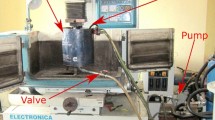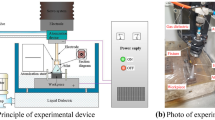Abstract
Powder mixed EDM is getting popularity due to its improved machining efficiency. The properties of powder particles play an important role in influencing the process. Therefore, the present work is focused on the phenomenon of electrical discharge machining (EDM) process for different dielectric conditions. Experiments on EDM have been performed using plain deionized (DI) water, nonconductive Al2O3 powder mixed DI water, and conductive Al powder mixed DI water as the dielectric. The experimental result shows that the conductive powder mixed EDM process is more stable and is able to generate better surface topography compared to other processes. To explicate the observation, sparking behavior, bubble formation, and interelectrode gap (IEG) for the different dielectric conditions have been investigated using high-speed camera. The average interelectrode gap was measured as 0.05 mm, 0.1015 mm, and 0.1392 mm in conventional EDM, nonconductive alumina powder mixed EDM, and conductive aluminum powder mixed EDM process, respectively. Similarly, mean sizes of bubble diameter in conventional EDM, alumina powder mixed EDM, and aluminum powder mixed EDM are observed as 0.1583 mm, 0.17789 mm, and 0.20621 mm, respectively.








Similar content being viewed by others
References
Marashi H, Jafarlou DM, Sarhan AAD, Hamdi M (2016) State of the art in powder mixed dielectric for EDM applications. Precis Eng 46:11–33. https://doi.org/10.1016/j.precisioneng.2016.05.010
Jameson EC (2001) Electrical discharge machining. Society of Manufacturing Engineers, Dearborn, MI
Jahan MP, Rahman M, Wong YS (2011) A review on the conventional and micro-electrodischarge machining of tungsten carbide. Int J Mach Tools Manuf 51:837–858
Kozak J, Rozenek M, Dabrowski L (2003) Study of electrical discharge machining using powder-suspended working media. Proc Inst Mech Eng Part B J Eng Manuf 217:1597–1602. https://doi.org/10.1243/095440503771909971
Zhao WS, Meng QG, Wang ZL (2002) The application of research on powder mixed EDM in rough machining. J Mater Process Technol 129:30–33. https://doi.org/10.1016/S0924-0136(02)00570-8
Abbas NM, Solomon DG, Bahari MF (2007) A review on current research trends in electrical discharge machining (EDM). Int J Mach Tools Manuf 47:1214–1228. https://doi.org/10.1016/j.ijmachtools.2006.08.026
Mu X, Zhou M, Ye Q (2019) Improving surface integrity and surface roughness by forming multi-discharging channels from one pulse in EDM. Int J Adv Manuf Technol 102:3181–3195
Chow H-M, Yang L-D, Lin C-T, Chen Y-F (2008) The use of SiC powder in water as dielectric for micro-slit EDM machining. J Mater Process Technol 195:160–170
Bhattacharya A, Batish A, Singh G, Singla VK (2012) Optimal parameter settings for rough and finish machining of die steels in powder-mixed EDM. Int J Adv Manuf Technol 61:537–548
Peças P, Henriques E (2008) Effect of the powder concentration and dielectric flow in the surface morphology in electrical discharge machining with powder-mixed dielectric (PMD-EDM). Int J Adv Manuf Technol 37:1120–1132
Jahan MP, Rahman M, Wong YS (2011) Study on the nano-powder-mixed sinking and milling micro-EDM of WC-co. Int J Adv Manuf Technol 53:167–180. https://doi.org/10.1007/s00170-010-2826-9
Mohanty S, Kumar V, Das AK, Dixit AR (2019) Surface modification of Ti-alloy by micro-electrical discharge process using tungsten disulphide powder suspension. J Manuf Process 37:28–41
Kumar A, Mandal A, Dixit AR, et al Comparison in the performance of EDM and NPMEDM using Al 2 O 3 nanopowder as an impurity in DI water dielectric. Int J Adv Manuf Technol 1–13
Tzeng Y-F, Lee C-Y (2001) Effects of powder characteristics on electrodischarge machining efficiency. Int J Adv Manuf Technol 17:586–592
Kumar A, Mandal A, Dixit AR, Das AK (2018) Performance evaluation of Al2O3nano powder mixed dielectric for electric discharge machining of Inconel 825. Mater Manuf Process 33:986–995. https://doi.org/10.1080/10426914.2017.1376081
Kumar S, Mandal A, Dixit AR (2018) Investigation of powder mixed EDM process parameters for machining Inconel alloy using response surface methodology. Mater Today Proc 5:6183–6188
Kung K-Y, Horng J-T, Chiang K-T (2009) Material removal rate and electrode wear ratio study on the powder mixed electrical discharge machining of cobalt-bonded tungsten carbide. Int J Adv Manuf Technol 40:95–104
Luzia CAO, Laurindo CAH, Soares PC, Torres RD, Mendes LA, Amorim FL (2019) Recast layer mechanical properties of tool steel after electrical discharge machining with silicon powder in the dielectric. Int J Adv Manuf Technol 103(1–4):15–28
Tang L, Ji Y, Ren L, Zhai KG, Huang TQ, Fan QM, Zhang JJ, Liu J (2019) Thermo-electrical coupling simulation of powder mixed EDM SiC/Al functionally graded materials. Int J Adv Manuf Technol 105:2615–2628. https://doi.org/10.1007/s00170-019-04445-z
Kansal HK, Singh S, Kumar P (2007) Technology and research developments in powder mixed electric discharge machining (PMEDM). J Mater Process Technol 184:32–41. https://doi.org/10.1016/j.jmatprotec.2006.10.046
Jeswani ML (1981) Effect of the addition of graphite powder to kerosene used as the dielectric fluid in electrical discharge machining. Wear 70:133–139. https://doi.org/10.1016/0043-1648(81)90148-4
Sahu DR, Mandal A (2020) Critical analysis of surface integrity parameters and dimensional accuracy in powder-mixed EDM. Mater Manuf Process 00:1–12. https://doi.org/10.1080/10426914.2020.1718695
Prihandana GS, Mahardika M, Hamdi M et al (2009) Effect of micro-powder suspension and ultrasonic vibration of dielectric fluid in micro-EDM processes-Taguchi approach. Int J Mach Tools Manuf 49:1035–1041. https://doi.org/10.1016/j.ijmachtools.2009.06.014
Prihandana GS, Mahardika M, Hamdi M, Wong YS, Miki N, Mitsui K (2013) Study of workpiece vibration in powder-suspended dielectric fluid in micro-EDM processes. Int J Precis Eng Manuf 14:1817–1822. https://doi.org/10.1007/s12541-013-0243-3
Wong YS, Lim LC, Rahuman I, Tee WM (1998) Near-mirror-finish phenomenon in EDM using powder-mixed dielectric. J Mater Process Technol 79:30–40
Kumar H (2015) Development of mirror like surface characteristics using nano powder mixed electric discharge machining (NPMEDM). Int J Adv Manuf Technol 76:105–113
Takezawa, H., Kobayashi, D., Asano, T., Mohri N (2008) A study on single discharge machining with low melting temperature alloy (12th report) relationship between bubble shape and removal volume of discharge crater,. Proc Spring Meet Japan Soc Precis Eng . 373–374
Takezawa, H., Kokubo, H., Mohri, N., Horio, K., Yanagida, D., Saito N (2007) A study on single discharge machining with low melting temperature alloy. Proc 15th Int Symp Electromachining 69–73
YOSHIDA M, KUNIEDA M (1996) Study on the distribution of scattered debris generated by a single pulse discharge in EDM process. J Japan Soc Electr Mach Eng 30:27–36
Hayakawa S, Kusafuka Y, Itoigawa F, Nakamura T (2016) Observation of material removal from discharge spot in electrical discharge machining. Procedia CIRP 42:12–17
Escobar AM, de Lange DF, Medellín Castillo HI (2020) Simplified plasma channel formation model for the electrical discharge machining process. Int J Adv Manuf Technol 106:143–153. https://doi.org/10.1007/s00170-019-04593-2
Otsu N (1979) A threshold selection method from gray-level histograms. IEEE Trans Syst Man Cybern 9:62–66
Koyano T, Suzuki S, Hosokawa A, Furumoto T (2016) Study on the effect of external hydrostatic pressure on electrical discharge machining. Procedia CIRP 42:46–50. https://doi.org/10.1016/j.procir.2016.02.184
Hogg RV, Tanis EA, Zimmerman DL (1977) Probability and statistical inference, vol 993. Macmillan, New York
Wang J, Han F, Cheng G, Zhao F (2012) Debris and bubble movements during electrical discharge machining. Int J Mach Tools Manuf 58:11–18. https://doi.org/10.1016/j.ijmachtools.2012.02.004
Kansal HK, Singh S, Kumar P (2005) Parametric optimization of powder mixed electrical discharge machining by response surface methodology. J Mater Process Technol 169:427–436. https://doi.org/10.1016/j.jmatprotec.2005.03.028
Janardhan V, Samuel GL (2010) Pulse train data analysis to investigate the effect of machining parameters on the performance of wire electro discharge turning (WEDT) process. Int J Mach Tools Manuf 50:775–788
Yoshida M, Kunieda M (1998) Study on the distribution of scattered debris generated by a single pulse discharge in EDM process. Int J Electr Mach 3:39–46
Author information
Authors and Affiliations
Corresponding author
Additional information
Publisher’s note
Springer Nature remains neutral with regard to jurisdictional claims in published maps and institutional affiliations.
Rights and permissions
About this article
Cite this article
Kumar, A., Mandal, A., Dixit, A.R. et al. Quantitative analysis of bubble size and electrodes gap at different dielectric conditions in powder mixed EDM process. Int J Adv Manuf Technol 107, 3065–3075 (2020). https://doi.org/10.1007/s00170-020-05189-x
Received:
Accepted:
Published:
Issue Date:
DOI: https://doi.org/10.1007/s00170-020-05189-x




